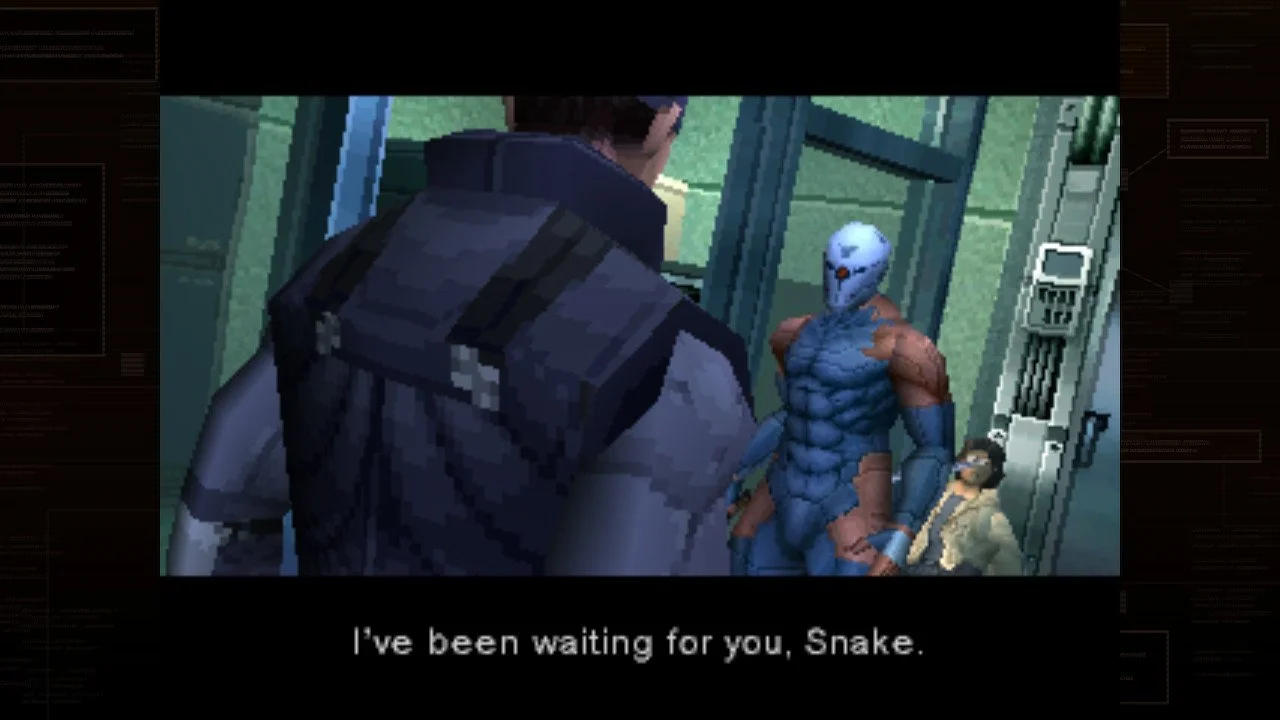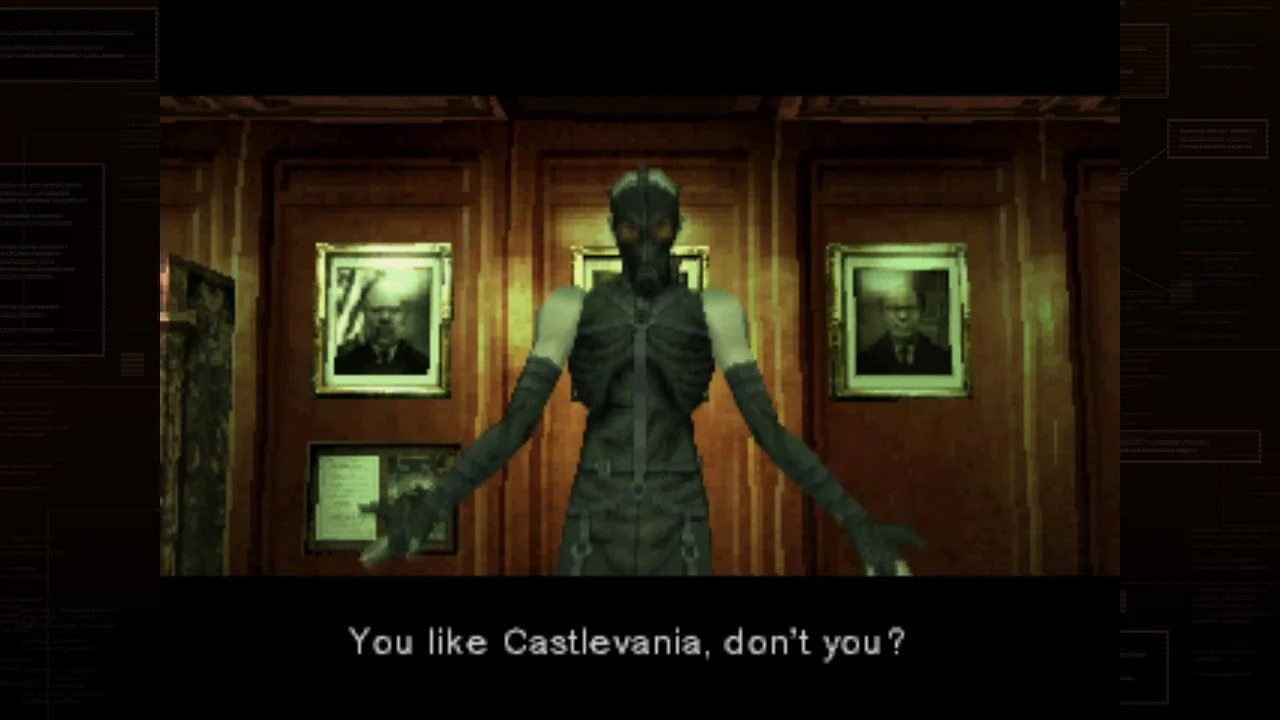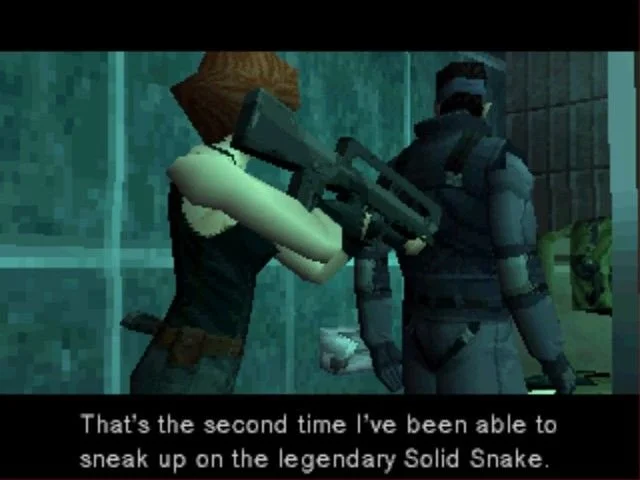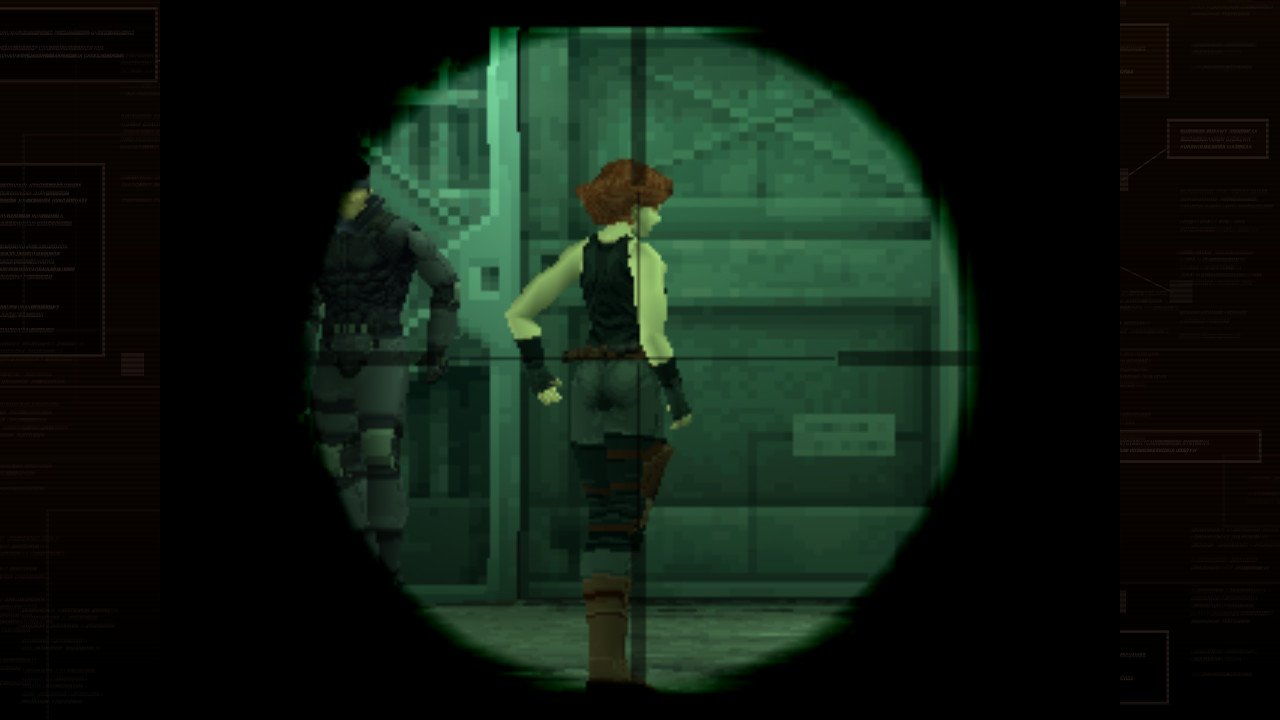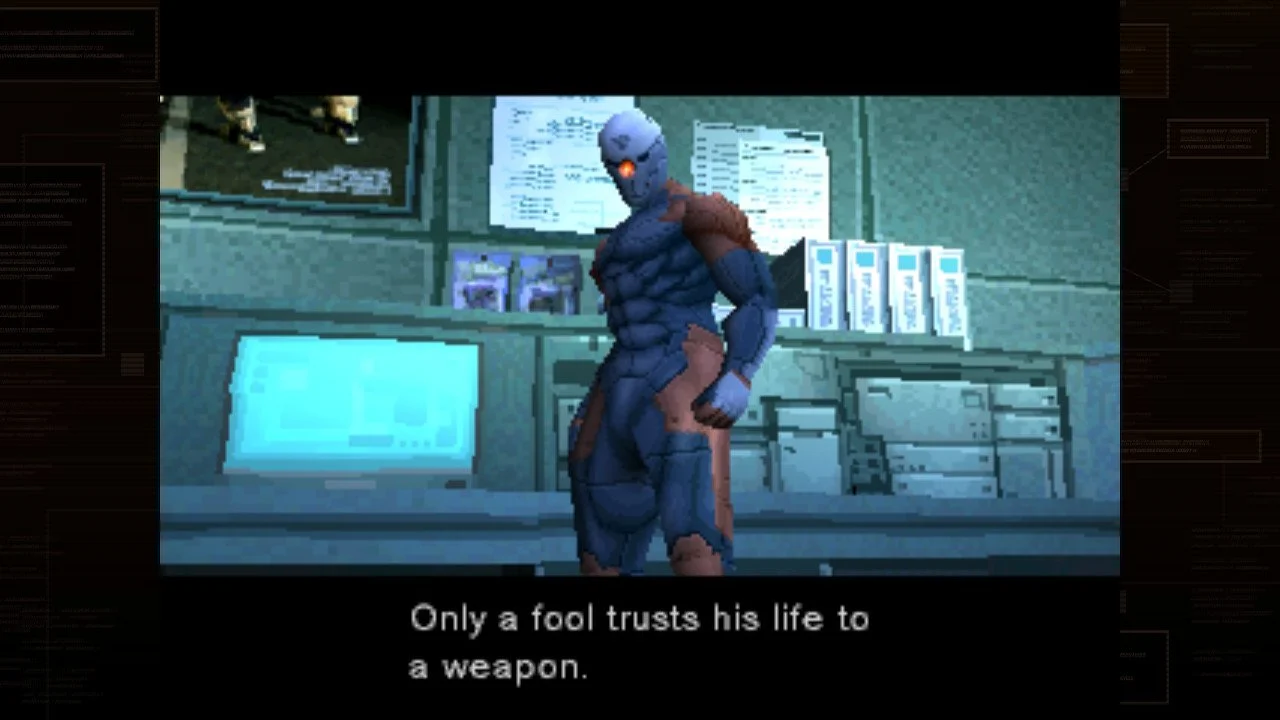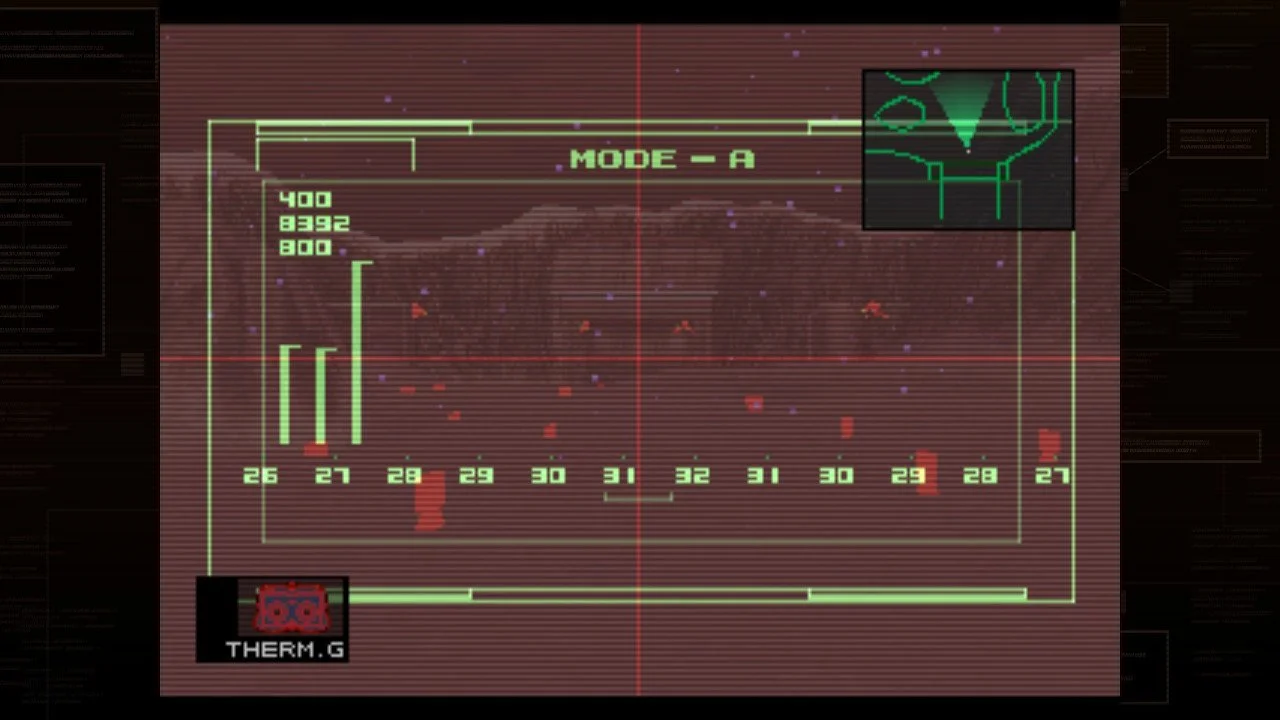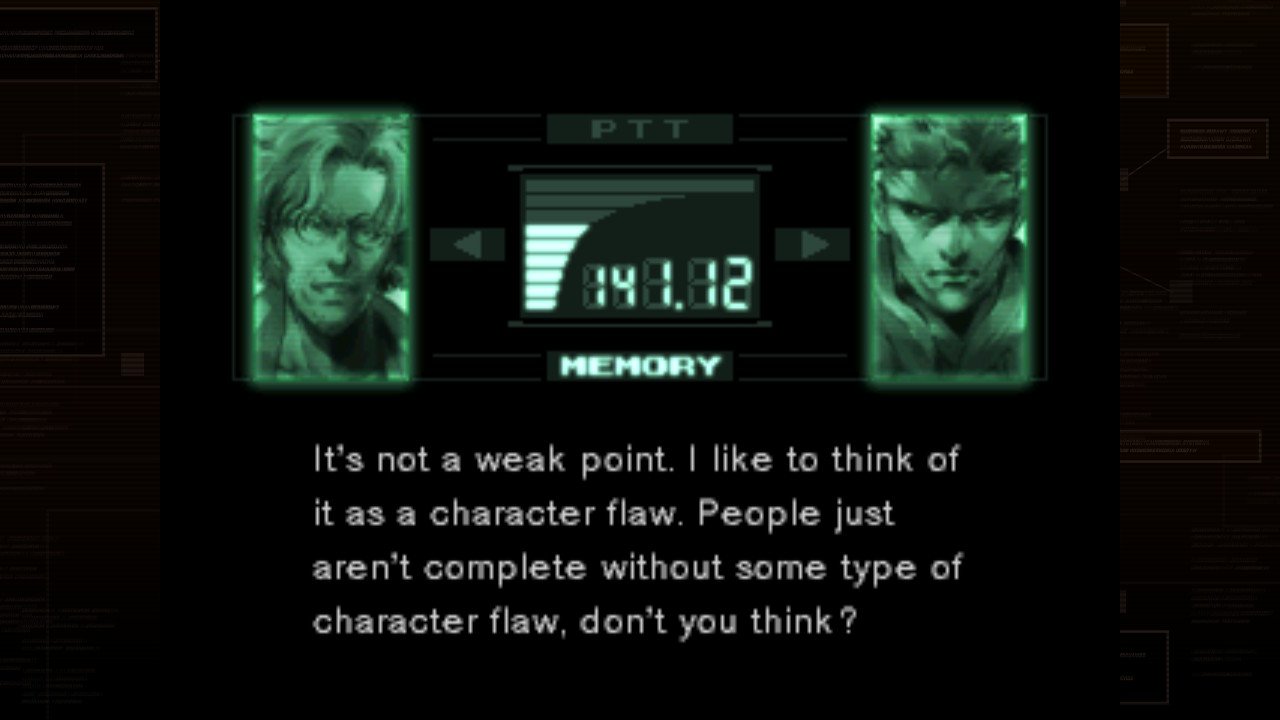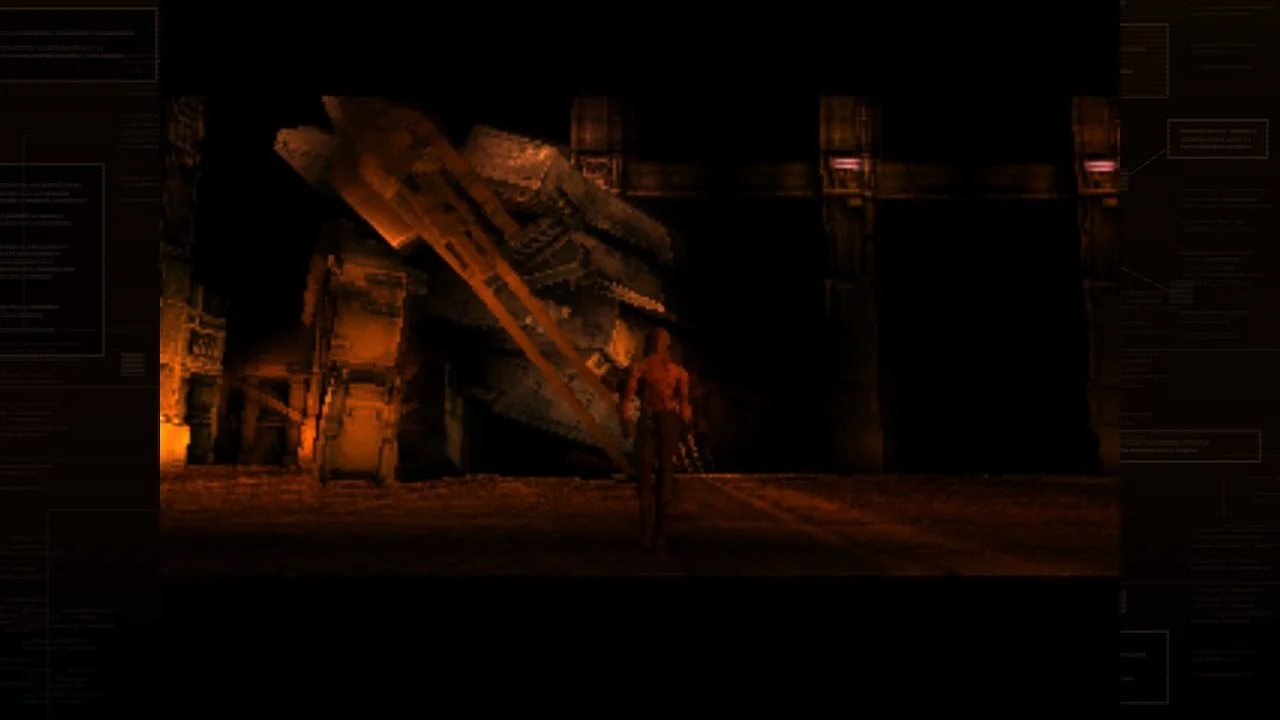Metal Gear Solid review
Metal Gear Solid was released for the original PlayStation around the same time I started high school, and it absolutely blew my mind. It was unlike anything we had ever seen before, and it had me absolutely obsessed from Day 1. Or, technically, from a bit before Day 1….
You see, back in the late 90’s, certain video game magazines would include demo discs that you could use to preview upcoming games. I recall picking up the occasional issue of these magazines specifically to play their included demo disc, and sometimes I wouldn’t actually read the magazine at all. This was how I first encountered several PS1 games, like Tekken 2, Crash Bandicoot, Fighting Force, and many, many others.
Official U.S. Playstation Magazine issue #13 - Pretty sure this was the one.
So back in the day, one of my friends picked up an issue of Official Playstation Magazine and its demo disc featured Metal Gear Solid. Imagine this scene: Three high school freshmen, sitting on the floor of my friend’s basement, passing the PS1 controller around as we take turns at this new stealth action game. Visually the game caught our attention, but the sneaking gameplay actually proved quite difficult to manage. We didn’t realize this game was a sequel to Metal Gear on the NES—a game which I had definitely played at some point in the past, but mostly forgotten—and we didn’t know that Konami would be re-recording all the in-game dialogue with English speaking voice actors. In the demo, all of the voiceover was still in Japanese. And yet it had the three us transfixed, me most of all.
The demo only contained the Docks and Helipad area; once you crawled through the vents to enter the Tank Hanger, the demo ended. Still, we couldn’t get enough of it. We replayed that demo over and over. We got used to the sneaking mechanics of leaning up against walls, knocking to draw guard’s attention, crawling under vehicles to hide or over puddles to avoid Snake’s footsteps making noise. We even mastered the technique of sneaking up on guards to grab them in a headlock and eventually snap their neck (a mechanic that took us a lot of practice to get right, for some reason). After hours of playing the demo, my friends and I were experts in Metal Gear Solid’s style of gameplay and we were pumped to experience the full game. So of course I bought the game as soon as humanly possible, in October 1998.
As previously mentioned on this site, Metal Gear Solid was part of the Stealth Holy Trinity, alongside Tenchu: Stealth Assassins (also on PS1) and Thief: The Dark Project (PC). I credit these three landmark games—which I sometimes also refer to as the Sneaking Class of ‘98—for essentially creating the Stealth genre in video games. However, compared to Tenchu and Thief, MGS actually feels like more of an action adventure than a stealth game. More on that later.
The thing about Metal Gear Solid is that it is, by my estimation, one of the single coolest things ever created. There are cool movies, of course, cool music, cool comic books, and plenty of cool video games; but almost nothing is as cool as Metal Gear Solid.
It’s got cyborg ninja, it’s got a giant mech, it’s got a sexy sniper lady, it’s got an old west-style gunslinger—who’s actually a Russian spy, I guess?—it’s got a snowfield fight with a tank and rooftop fight with a helicopter. It’s got a reluctant protagonist, a badass mercenary named Snake, who’s forced to work for the US government against his will. (Or am I thinking of the movie Escape from New York?) Even its tagline, “Tactical Espionage Action”, is undeniably rad. It’s hard to get much cooler than this.
The thing that made MGS exponentially cooler, of course, was its groundbreaking cinematic presentation. With heavy use of cutscenes, an expertly translated script courtesy of Jeremy Blaustein, and just absurdly good voice acting, it is genuinely amazing how cinematic this game managed to be. And on the PS1 no less! Never before did you really feel like you were controlling an action movie in progress. Here you definitely did, and it was probably a movie directed by John Carpenter.
The story of MGS featured an espionage plot at least as intricate as any spy thriller film. While referencing characters and events from the previous two Metal Gear games, it wove in themes of nuclear proliferation, advances in DNA sequencing and manipulation, global political intrigue, and how these things affected the fate of individuals, and the world, in an uncertain post-Cold War era. Basically the game has a good story and it delivers that story exceptionally well.
Part of what makes the story work so well is the game’s eclectic cast of characters. Despite the serious tone of nuclear deterrence, and the realistic guns and military equipment, many of the characters you encounter in MGS—especially the villains—are outlandishly stylized, like something out of manga or anime. Psycho Mantis, the master of telepathy and telekinesis, wears a gas mask and a trench coat over his leather BDSM outfit. Vulcan Raven, the hulking heavy bruiser, never wears a shirt even in the subzero cold, because that would obscure the numerous raven tattoos covering his body. Sniper Wolf never zips her jacket up very high because, presumably, her cleavage must be visible at all times.
This blend of realism and comic book fantasy is what gives Metal Gear its trademark flavor, and in large part, what has made the series so memorable. There just isn’t anything quite like it. And while everyone praises director Hideo Kojima for creating the Meta Gear series, I think it’s worth pointing out that artist Yoji Shinkawa was vital to defining the characters and visual design that made MGS so successful.
Yoji Shinkawa’s artwork is stylish as hell.
The setting of Shadow Moses Island, in Alaska’s Fox archipelago, is absolutely pitch-perfect. The military base/research facility you are sneaking into feels like a plausibly real place, cold and desolate. The entire base isn’t even very big in terms of square footage, but its various components are so detailed, you really feel Snake’s physical journey from Point A (the Docks) to Point B (Metal Gear Hanger, deep underground). The story does force Snake to backtrack a couple times—first to pick up the sniper rifle and then the PAL code sequence near the end of the game—so you really end up getting the lay of the land down in your mind.
Some video games manage to nail their setting—this tangible “sense of place”—so well, that anytime you replay the game, it feels like you are paying a visit to this real location from your past, returning somewhere physically. MGS is definitely one of those games.
The music in MGS is fantastic throughout, conveying just the right emotional tone at all times. The main theme and most background tunes are perfect for that action-movie-come-to-life that this game represents. And the end credits song, called “The Best is Yet To Come”, with its Irish vocals is a truly amazing touch. It’s ethereal, evocative, and hauntingly beautiful, exactly the type of unique musical flourish you could only find on the PS1 at the time.
Ok, let me take a moment to compare three different versions of Metal Gear Solid and explain what differences I could find.
PS1 version
The original PlayStation is of course where MGS first launched, so let’s check that out first. The original release is still a great way to play MGS…assuming you have a PS1 and a copy of MGS laying around, that is. Or perhaps you have some way of emulating this game on a modern machine?
Booting up my old copy of MGS on the PS1 and playing on a CRT television still feels kind of magical. For one thing, that PS1 bootup sequence is so unbelievably nostalgic, it gives me chills. And playing this game on the now ancient DualShock controller feels like home.
How Ocelot looks on PS1.
Visually this game still looks incredible today. Granted, objects and character models has a low polygon count, and textures are quite low resolution. Plus you can see that classic PS1 polygon jittering here and there. Yet, through some magical combination of color grading, filters, and probably some other tricks I don’t know about, the game actually looks great. I especially like the spark effect when bullets hit a metal surface or wall, that’s incredibly cool.
On the other hand, this game is super dark. And I don’t mean thematically, I mean it’s quite dimly lit. It’s so dark that it becomes genuinely hard to see details in most environments. And wow, crawling in vents is almost pitch black! I’m suddenly remembering that I used to equip the Thermal Goggles at weird times, just to ensure that I could see where I was going in the dark. Were CRT’s always this dark? Or is it just because my current TV is so old? After cranking the screen brightness way up, it looks much better.
In the scene where Snake encounters Meryl for the first time, right after talking to the DARPA Chief, there’s a guard that Meryl has knocked unconscious and stolen his uniform. That guard is named Johnny Sasaki, and you see him again in Medical Bay when Revolver Ocelot is keeping Snake hostage for torturing purposes. Anyway, in the original US release of MGS, Meryl takes all of Johnny’s clothes—even his underwear, I guess—and leaves him on the floor completely naked. Snake exits the DARPA Chief’s cell to see this poor guy unconscious on the floor, face down but ass up, with a big pixelation effect covering his undercarriage.
Now this was a pretty good joke, and ironically kind of made you feel bad for this one random guard. Unsuspectingly hitting the player with full nudity, though tastefully blurring out any genitalia—of course they wouldn’t have had the capability to render such details if they’d tried—was genuinely funny and felt a bit risque. It was a good gag that, in its own juvenile way, almost helped the game feel more mature. Remember this naked Johnny bit, as we’ll come back to it later.
In the cutscene after the fight with Revolver Ocelot, when the Ninja first appears, Snake’s SOCOM pistol will have the suppressor attached, whether or not the player has already acquired this item. This is a bit of continuity goof but most players probably won’t notice.
PC version (GOG)
The PC release of Metal Gear Solid is still available on Good Old Games (GOG), so let’s check out that version as well.
The visuals are surprisingly clear in this PC version…a little too clear, in fact. You’re still looking at PS1 era low-number polygons and low-res textures, but it’s missing the jaggy edges and most of the jittering from the original. It’s also less blurring in-game, for some reason. That said, I’m noticing more issues with visible gaps between polygons, so you can actually see the seams, like a bit of blank whiteness where two polygons are failing to meet. The game looks clearer than the original, but its blemishes are much more apparent too.
How Ocelot looks on GOG.
While my controller was recognized by this game, I needed to do a little work to fix the button bindings. For some reason, the shoulder buttons were all messed up, so I needed to correct the assignments for those four buttons specifically.
Unfortunately this game has a lot of audio bugs. Sound will sometimes get limited to one channel, meaning that it only comes through one headphone. The voice audio will occasionally drop out completely, whether in codec calls or in a cutscene. General audio functionally is just inconsistent throughout.
In the scene where Snake encounters Meryl for the first time, right after talking to the DARPA Chief, the poor guy that Meryl knocked out—good old Johnny Sasaki—is now wearing boxer shorts? He’s still face down (ass up) unconscious, but he’s wearing tan boxer shorts instead of being completely nude. The heavy pixelation effect isn’t present either, since there’s no extreme nudity to cover up. Unfortunately this isn’t nearly as funny as remember this gag being.
Well it turns out that Johnny was only rendered completely nude in the original release of MGS on PS1, and I guess on in the North American version. This PC release, which came out in 1999, is called the "Integral" version, and it was also released on PS1 in Japan the same year. Apparently in Integral Johnny wears underwear. Who knew?
Master Collection version
The version of MGS included in the Metal Gear Solid: Master Collection Vol.1 attempts to recapture the magic of the game’s breakout success on the PS1. In order to do this, it needs to add a few elements that harken back to the PS1. For example, the game has a virtual memory card function where you can add saves for Castlevania SOTN, Suikoden, Silent Hill and more. Added these saves to your virtual memory card enables Psycho Mantis to read and react to them when you encounter his bossfight.
Similarly, pressing L and R at the same time brings up a menu where you can do things like change which controller port you’re using. Again this is related to the Psycho Mantis fight, as the original game forced you to plug your controller in Port 2 into to prevent Psycho Mantis from cheating by “reading your inputs”. Ironically though, none of the controller vibration tricks in MGS have worked for me in this version, playing on Nintendo Switch. I’m not sure if there’s a setting I need to change, if the specific controller I’m using is incompatible with this game somehow, or if that’s just a bug. Strange, in any case.
Here’s a weird move: They include a disclaimer right before launching MGS that the game has some “outdated themes”, but they say they’ve left everything in, unchanged. Mei Ling still has her bad Chinese accent—something they discarded for the Twin Snakes remake on GameCube—so I figured that’s the kind of potentially offensive material they are opting to leave in.
But hey, in the scene where Snake encounters Meryl for the first time, right after talking to the DARPA Chief, Meryl’s wardrobe heist victim (Johnny Sasaki) is wearing boxer shorts?! I definitely selected to play the original 1998 version, and they explicitly said they weren’t going to change anything. And yet they have partially clothed our naked Johnny. What gives?
Well this doesn’t match my memories of playing MGS at all.
Johnny’s underwear is an indication to me that Konami didn’t actually give us the original PS1 version in this collection. It seems like this is the “Integral” version instead. When you boot up the game, you get to choose which version of MGS you want to play, so it’s baffling to me that they’d claim to offer the original 1998 version and the Integral 1999 version, when it’s going to play the same thing either way. And this is obviously a minor detail, but the joke is much less funny this way.
Visually this version of MGS is definitely in standard definition, meaning that it looks appropriately blurry. It seems to have all the visual defects of the PC version—texture tearing here and there, visible seams between polygons—without the overall clarity the PC had delivered. It kind of seems like the unholy combination of the original PS1 and the PC in terms of visual fidelity, somehow providing the worst aspects of both. And yet, it’s fine. I got used to the blurriness almost immediately and the little visual blemishes I noticed didn’t really detract from the overall experience. Does it look worse than the PS1 game it’s emulating? Yes. Does that bother me? No.
Generally speaking, the 3D-but-mostly-just-topdown-perspective stealth gameplay here is still super fun. Things are still a bit awkward to control. Like when I’m trying to lean up against a wall, but somehow managing to send Snake running around the corner instead, directly into a guard’s view. But sneaking around the base, crawling under trucks, occasionally donning a cardboard disguise, and snapping a neck here or there is still a lot of fun. Although I noticed that the game has at least as much action as it does stealth. You’re mainly only sneaking around for a bit before hitting the next bossfight and/or action set piece.
Speaking of bossfights, they are extremely memorable and might be the Metal Gear series’ most impressive gameplay feature. Encounters are quite unique and fun to figure out, and rarely feel frustrating or overly difficult. I’d say the Sniper Wolf fights have probably aged the worst, and those can still be pretty fun…when you’re not overly distracted by fighting with the game’s frustrating equipment management UI, that is.
MGS’s biggest flaw, in my opinion, is that its system for managing weapons and equipment is pretty clunky and awkward. The fact that you can use items and also have certain items equipped—both of those things are handled with the L button(s)—makes for an exercise in frustration and frequently interrupts the action. This is especially true with the long-distance firefights against Sniper Wolf. You’ll need to open the item menu every so often to use Diazepam, but you’ll probably want to leave with your Rations between the equipped item. Or perhaps you’ll want to leave with Body Armor or the Thermal Goggles equipped. But, in any case, it’s frustratingly awkward.
This is also a problem with managing Snake’s weapons with the R button(s). The big showdown with Metal Gear Rex is a great example of this, because you’ll want to toss out a Chaff Grenade every so often to mess with Rex’s sensors, but then whip out the Stinger missile launcher to deal damage. This means you’re having to roll through your weapon inventory and pick out each of these tools each time, whilst simultaneously running around to avoid getting shot, blown up, or stepped on. Playing today, it really feels like your fight is more against the terrible UI than your massively mechanized opponent.
Speaking of weaponry, everything Snake gets to use is pretty cool. The silenced SOCOM pistol, FAMAS machine gun, and PSG-1 sniper rifle are pretty standard action movie stuff. But then the Nikita remote-controlled missiles are just rad as hell. I especially love how you can hold the first-person view button (Triangle on PS) to guide the missile from a first-person perspective. After collecting the Nikita missiles I looked for any old excuse to use them. Super fun!
Ok guys, we might have gone overboard with adding mines and turrets here.
One very old-school element of MGS are the traps. Trapdoors in the floor, claymore mines hidden in various places, laser tripwires; these various hazards you encounter in the environment harken back to 2D adventure games. One particularly egregious example are the surveillance cameras in the control room where you enter the PAL codes. You need to enter that room three times, so you’d better remember to toss a Chaff Grenade first or you can slowly die from poison gas. Lame.
While MGS’s boss fights are generally a great addition, the final showdown(s) with Liquid Snake are a lot less fun than I remember them being. The fistfight on top of the Metal Gear Wrecked feels particularly annoying, with plenty of times where Liquid can cheaply smack you a couple times and drain your limited health. It kind of just feels unfair. I remember these parts all feeling pretty epic back in the day, but not so much now. Plus Liquid sucks and I’m glad he’s dead.
After playing through Metal Gear Solid again, I find that I still appreciate its intricate story, its wild characters, its incredible score, and especially the unbelievably cinematic presentation. It remains an interactive tour de force. However, I am realizing that for a video game that popularized the stealth genre, it doesn’t actually have that much stealth gameplay in it. Especially compared to Tenchu and Thief, MGS is much more of an action game. I suppose that’s why the tagline “Tactical Espionage Action” didn’t actually use the term “Stealth” at all.
True stealth game or not, Metal Gear Solid is an undeniable classic and you should definitely play it. Personally I think the PS1 original is still the best version to play, whether on original hardware or emulated. But the Metal Gear Solid: Master Collection Vol.1 version is also perfectly fine and more easily accessible. So you should be alright going that route as well.
Patrick’s Thoughts on MGS
It’s been really interesting to play through Metal Gear Solid because I realize now that I watched Luke play every part of the game. Every single cutscene is very familiar to me even though I’ve never played the game. So it’s weirdly nostalgic in that way.
I always remember MGS being a thoroughly 3D game, but I realize now that it is very much a 3D-rendered top-down game, reminiscent of the original Metal Gear or Metal Gear Solid on Game Boy Color, which is the only other game in the series that I’ve played. Somehow in my mind I imagined it playing like Splinter Cell, with an over-the-shoulder view. I appreciate that MGS stays true to that same style.
I also didn’t realize that there is a somewhat nonlinear layout to the game, where you end up backtracking on occasion to access areas you couldn’t before. It makes it feel sort of like Metroid. And you get the sense that the base you’re infiltrating is not just a military base-themed path you have to follow, but rather is a believable facility. I like that a lot.
But I gotta say, I was not expecting there would be so much about this game that I don’t like.
First and foremost, the controls suck pretty bad, even for late 90’s standards. When you hide against a wall, the camera angle changes, but the directional buttons still move Snake relative to the top-down view instead of the view that the player is being shown. That’s really annoying.
In both the weapon menu and the item menu, you have to select and equip/unequip the item, which feels really clunky. And a couple of the items only get used in cutscenes, but you have to cycle through them in your menu anyway in order to get to items that are actually usable.
You have to manually equip the Keycard in order to open doors, even though the in-game dialogue suggests it is wireless technology that works automatically when a Keycard is near a door. Same goes for Body Armor and the Gas Mask. Snake can’t possibly wear both at the same time, let alone wear one and hold a Keycard simultaneously. All those items can only be used one at a time and it makes no sense.
For example, you find yourself needing to equip the Keycard to open a door to an area with poison gas, immediately open the menu and cycle through to the gas mask, then leave that area by removing your Gas Mask (while still breathing poison gas) to select the Keycard in order to open the exit. That kind of tedious menu work pops up repeatedly. Acceptable on a gen1 Game Boy game, maybe.
In order to run and shoot at the same time, you have to hold down the Crouch button as you tap the Shoot button. But if you hold the Crouch button before shooting, you will go prone, where you can’t shoot at all. So you have to either start shooting and begin holding Crouch as you’re shooting, or you have to press Crouch to go down, press it again to stand up, and then hold that button from there as you begin shooting. This is unforgivable.
And speaking of shooting, for most of the guns, you hold the shoot button to aim (which means just aiming side-to-side since it’s top-down), and then release the button to shoot. Except with the machine gun, it just shoots upon pressing the button. It is an annoying little inconsistency.
Then you have a couple weapons which put you into first-person view, and those really suck. The sniper vs sniper fights, which are $#*^!& in every game, are borderline unplayable in MGS. As if the game aspired to be a realistic sniper simulator, your crosshairs jiggle as you breathe, and if you want to stop the movements temporarily, you have to take pills which you find laying around as an item.
Snake reconnects with his childhood by playing with ketchup on the floor.
My next complaint is that you collect some interesting items and weapons that you end up having almost no opportunity to use. The steady aiming pills exist only for those two scripted sniper battles; not near enough to warrant their inclusion in the game. The fly-by-wire missile launcher, one of the cooler weapons, is frequently listed as unavailable in the weapons menu without any further explanation. The standard grenades are necessary for one boss battle and don’t seem to be useful for much else. It is very disappointing.
Thirdly, the boss battles are way too frequent compared to the stealth portions. Ideally the boss fights should not even exist in a stealth game, particularly a stealth game with $#*^!& combat controls and a bad menu system, but luckily the boss characters are interesting, the dialogue is memorable, and the voice acting is really good. I think that is probably why the game is so celebrated, not the gameplay.
It feels like there’s about one boss battle and accompanying cutscenes for every two or three small areas that you sneak through. It keeps the plot clipping along, but it feels like there is not a lot of actual sneaky stealth fun to be had.
My last issue with the game is not specific to MGS; the final boss is difficult, and there’s no incentive to grind away at beating it, because the game is over after that anyway. I appreciate that the last couple Zelda games have had surprisingly easy final battles compared to the bosses earlier in the game. When you’re getting to the conclusion of the story, there should be a reasonable chance that a player could beat that final challenge on their first attempt without killing the momentum.
And that’s the problem with having a big mismatch between the boss battle mechanics and the core game mechanics. Tenchu is guilty of that big time as well.
To be clear, I didn’t dislike MGS. I just knew it’s a classic and sort of expected it to be perfect. I definitely enjoyed it, after all I played (almost) all the way through it.
Poor Johnny…that guy really can’t catch a break.



